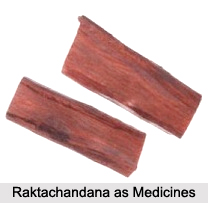 Raktachandana, scientifically named as Pterocarpus Santalinus is an important medicinal tree indigenous to the Indian Peninsula and is chiefly of importance from its yielding the red dye-wood known as "Red Saunders", large quantities of which are annually exported from India. It has been used in almost all the traditional system of medicine, Ayurveda, Unani and Siddha from the ancient time. It serves as a folk medicine in traditional uses.
Raktachandana, scientifically named as Pterocarpus Santalinus is an important medicinal tree indigenous to the Indian Peninsula and is chiefly of importance from its yielding the red dye-wood known as "Red Saunders", large quantities of which are annually exported from India. It has been used in almost all the traditional system of medicine, Ayurveda, Unani and Siddha from the ancient time. It serves as a folk medicine in traditional uses.
Sanskrit writers describe several varieties of sandal or Chandana. Of these Srikhanda or white, Pitachandana or yellow, and Raktachandana or red sandal wood are best known. The first two varieties are founded on the difference in the shades of the colour of the wood of Santalum Album. Both sandal wood and red sandal wood are rubbed on a piece of stone with water, and the emulsions are used for painting the body after bathing and in Hindu religious services.
Health Benefits of Raktachandana
Red sandal wood is described as an astringent tonic. It enters into the composition of numerous prescriptions of an astringent character and of cooling external applications for inflammation, headache, etc., but is seldom used alone. It is also much used as a coloring agent in the preparation of medicated oils.
This article is a stub. You can enrich by adding more information to it. Send your Write Up to content@indianetzone.com
Related Articles
Ayurveda
Ayurveda Medication
Elements of Ayurveda
Concepts of Ayurveda
Ancient Literature of Ayurveda





